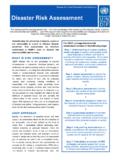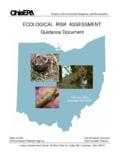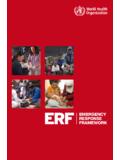Transcription of A FRAMEWORK FOR MAJOR EMERGENCY …
1 A FRAMEWORK FOR MAJOR EMERGENCY management GUIDANCE DOCUMENT 1A GUIDE TO RISK assessment IN MAJOR EMERGENCY MANAGEMENTJANUARY 2010 A FRAMEWORK for MAJOR EMERGENCY management (2006) replaces the Frameworkfor Co-ordinated Response to MAJOR EMERGENCY , which has underpinned majoremergency preparedness and response capability since 1984. The FRAMEWORK sets out the arrangement, by which the principal responseagencies will work together in the management of large-scale incidents. This Guide to Risk assessment in MAJOR EMERGENCY management is intended tosupport the FRAMEWORK text and to provide additional guidance on the riskassessment process. The guideance document is presented as best practice in the area of RiskAssessment for MAJOR EMERGENCY management .
2 Guidance documents areadministrative instruments not having the force of law and, as such, allow forflexibility in approach. Alternate approaches to the principles and practicesdescribed in this guidance described may be acceptable provided they aresupported by adequate justification. Alternate approaches should be discussed inadvance with Project Team, Fire Services and EMERGENCY Planning Section,Department of the Environment, Heritage & Local Government,Custom House,Dublin to A Guide to Risk assessment PageIntroduction3 Part 1 5 The Risk assessment ProcessPart 214 Using the Risk AssessmentTables and Templates17 Individual Hazard Record Sheet Template25 List of FiguresFigure EMERGENCY management ParadigmFigure Risk assessment ProcessFigure Risk MatrixFigure (a) The Risk Matrix ZonesFigure (b)
3 The Risk Matrix ZonesList of Tables and TemplatesTable 1 Example to Illustrate Establishing the Context Table 2 Classification of LikelihoodTable 3 Classification of ImpactTable 4 Hazard Identification TemplateTable and International Examples- Natural HazardsTable and International Examples- Transportation HazardsTable and International Examples- Technological HazardsTable National and International Examples- Civil HazardsContents12 IntroductionThe systems approach to MAJOR EMERGENCY management involves a continuouscycle of activity. The principal elements of the systems approach are: Hazard Analysis/ Risk assessment ; Mitigation/ Risk management ; Planning and Preparedness; Co-ordinated Response; and RecoveryFIGURE EMERGENCY management ParadigmRisk assessment is a process by which the hazards facing a particular communityare identified and analysed/assessed in terms of the threat/risk which they prepare effectively for dealing with potential emergencies it is necessary tohave regard to the specific risks faced by a community.
4 Including formal RiskAssessment as part of EMERGENCY planning is increasingly recognised as bestpractice nationally and internationally. In the FRAMEWORK the risk assessmentprocess is used as a basis for the decision-making associated with the otherelements of the EMERGENCY management FRAMEWORK requirement is that:Each principal response agency should, in association with its partner principalresponse agencies, carry out a risk assessment in accordance with theprocedures set down in Section 2 of the FRAMEWORK and this Guidance. Theinitial rise assessment should be reviewed and updated annually, or ascircumstances Guidance sets out a risk assessment procedure that should be applied anddocumented by the principal response agencies as a basis for MAJOR emergencymanagement.
5 The risk assessment procedure underpins work in the later stages ofthe EMERGENCY management cycle. A significant benefit of the risk assessmentprocess is that it can help establish confidence in the MAJOR EmergencyManagement system, by showing it to be both realistic and logical. This risk assessment approach is complementary to the principle of an All-Hazards approach discussed in Section 1 of the FRAMEWORK . Section 2 of the FRAMEWORK introduced the risk assessment process and defined thefollowing terms (See also Appendix F3): Hazard: Any phenomenon with the potential to cause direct harm to membersof the community, the environment or to physical infrastructure, orbeing potentially damaging to the economic and social : The consequences of a hazardous event being realised, expressed interms of a negative impact on human welfare, damage to theenvironment or physical infrastructure or other : The combination of the likelihood of a hazardous event and itspotential guidance is divided into two parts.
6 Part one details the four steps of the riskassessment process while part two provides guidance on how the risk assessmentshould be employed to inform mitigation and detailed planning. A Tables andTemplates section is included that contains documents designed to support the riskassessment process. It should be noted that tables and templates do not purportto exhaust all potential possibilities but rather should be used as guides to beadapted to Local/Regional circumstances. 4 PART 1- The Risk assessment ProcessIt is recommended that the risk assessment process should be carried out initiallyby each principal response agency, before being undertaken and documented byan inter-agency team, working under the aegis of the Regional Steering Group onMajor EMERGENCY management .
7 The relevant outcomes from the regional processshould be incorporated into each principal response agency s own majoremergency plan. The risk assessment comprises four stages as illustrated in Figure below: the potential hazards on a risk matrixFIGURE Risk assessment Process5 Risk assessment StagesStage 1 - Establishing the ContextThe purpose of this stage is to describe the characteristics of the area for which therisk assessment is being completed, as this will influence both the likelihood andthe impact of a MAJOR EMERGENCY . Establishing the Local/Regional context enablesa better understanding of the vulnerability and resilience of the area toemergencies. Each principal response agency should undertake an initial local risk process begins for each agency by establishing the context in which the riskassessment is taking place.
8 MethodologyThe team undertaking the risk assessment exercise should consider the national,regional and local contexts which impact on MAJOR EMERGENCY management intheir area. The outcomes should be recorded in a series of short statements. Toassist in this, the team should reflect on the relevant aspects of their area,considering emerging and potential future trends, in addition to the currentsituation. It will be appropriate also for the team to establish links with bodies thatcould provide relevant information/input for the risk assessment process. Thesecould include bodies such as the Environmental Protection Agency (EPA), theHealth and Safety Authority (HSA), the Food Safety Authority (FSA), Port andHarbour Authorities, and Airport Authorities.
9 Social:Describe the demographic, ethnic and socio-economic compositionof the community. How are the various communities geographicallydistributed within the area? Are there any particularly vulnerable groups inthe community? Are there annual events during which there is an influx ofpeople into the area Festivals and Concerts? How experienced is thecommunity at coping with different types of emergencies? Is there a strongvolunteer/community support ethos? Environment:Is the area to be assessed urban, rural or mixed? Are thereany particular local geographical factors contributing to vulnerabilities? Arethere particularly high-density areas? Are there specific environmentallysensitive/amenity areas?
10 What is the history of events in or adjoining thearea? Infrastructure:How is the infrastructure configured in the area - transport(road, rail, air, sea), utilities, business, etc? What are the critical supplynetworks in the area? Are there any sites in the area that are particularlycritical for local, regional or national essential services ( hubs, power generation, fuel /energy supply, medicalfacilities, educational establishments, head offices of large public orcommercial concerns)? What are the drivers of the economy in the area? Hazardous sites:What potentially hazardous sites exist in the area? Whereare they in relation to communities or sensitive environmental areas?






